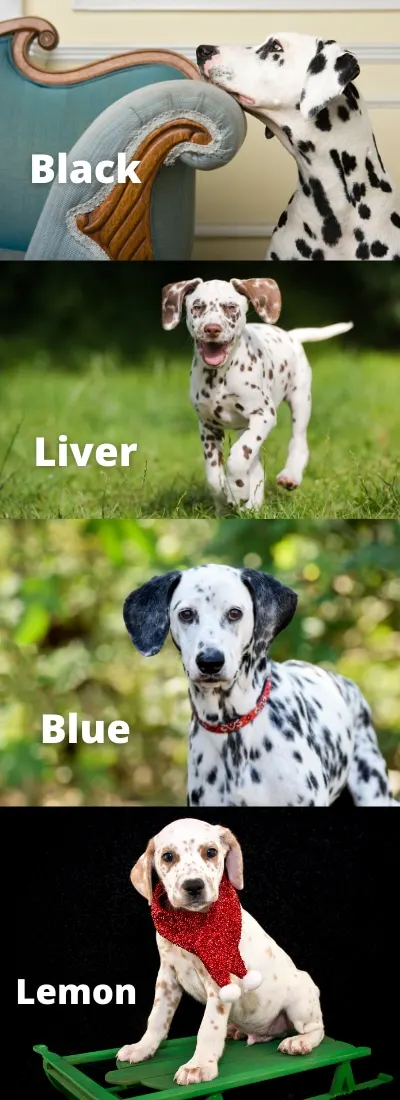Dalmatians are the only dog breed to have real “spots” in their coat. It’s something that makes them truly unique, and naturally, there are many questions to be asked.
When do these spots develop? How big and what color will they be? All FAQs are answered below!

Table of Contents
Are Dalmatians Born With Their Spots?
No, Dalmatians are not born with their spots and as newborn puppies, they are all pure white. Their spots develop shortly over time.
You have probably seen 101 Dalmatians… If you can remember the scene when Perdita has her 15 puppies, they all had pure white coats with light-colored noses!
For many owners, waiting for the first glimpse of their spots to come through is an exciting time. You don’t know where they will be, what shape they will be, or the color!
When Do Dalmatians Get Their Spots?
Dalmatian puppies start developing their spots at around 2 weeks of age. And by 4-6 weeks of age, most dalmatian puppies will have further defined their spots and they will appear much clearer.
But it doesn’t stop there! Even though you will see their spots at 4-6 weeks, they are still young and their spots will continue to develop for several months. The most significant changes will be the definition and outline of the spots as well as the strength of color.
Additionally, your Dalmatian will be several times bigger in physical size by around 12 months of age. This means their small bodies just won’t display all of their future spots in the early stages.
Do Dalmatians Have Spotted Skin?
Yes! Dalmatians have spotted skin too. Underneath the spots of hair will be an identical spot of skin. To see this clearly you can look on the underbelly of any dalmatian where the skin is easy to see.
You might also be surprised to know that Dalmatians have spots inside their mouth too!
When Do Dalmatians Have Fully Developed Spots?
It takes a lot longer than many owners first realize for their Dal’s spots to settle.
Dalmatians continue to develop their spots until around 12-18 months of age. This means their final size, shape, and outline may continue to adjust and darken until this moment. Albeit very slightly.
It will appear, however, that their spots have settled much before this moment, and that’s simply because it can be very hard to see the final changes.
An amazing fact about Dalmatians is that every single coat pattern is entirely unique! There will be no other Dalmatian in the world with the same pattern!
Psst… Check out these trending Dalmatian articles when you’re done here!
Do Dalmatians Go Blind or Deaf? The Full Answer + FAQs
Why Many Dalmatians Are Smaller Than They Should Be
What Color Spots Can Dalmatians Have?
You may be surprised to know that Dalmatians don’t just boast black spots with a white coat. There are a few more color variations possible, although they are considerably less common.
Spot/Coat colors of Dalmatian:
- Black colored spots with a white coat
- Liver colored spots with a white coat
- Blue colored spots with a white coat
- Lemon colored spots with a white coat
- Black & Liver colored spots with a white coat (tricolored)
- Sable colored spots with a white coat (only one single Dal known so far)
The list above is in order of popularity. Of course with black spots being the most popular.

Lemon is so rare that it’s hard to find a good example online. This is very close to being “lemon” but may in fact be a light liver. I suggest googling “lemon dalmatian” to see if there are updated results.
Tricolored Dalmatians are also very rare. This color is classified as having a random mixture of black and liver-colored spots within the same coat.
Do Dalmatian Spots Change With Old Age?
Some Dalmatians will indeed have spots that change in appearance as they reach old age.
Some owners have labeled this change “ghosting”. This is where the once dark-colored hair gradually begins to go white, but the skin underneath remains to hold the dark color. This gives the appearance of a “ghosted” spot.
“Ghosting” may not happen with every dalmatian, and your Dalmatian could even experience a different change.
Many owners claim their Dalmatian has gained more spots throughout old age. This may be true, although it hasn’t been officially proven or disproven.
Additional Dalmatian Articles:
Do Dalmatians Shed? How To Reduce Dalmatian Shedding
Do Dalmatians Like Water? Dalmatian Swimming Tips
Thank you for reading!
